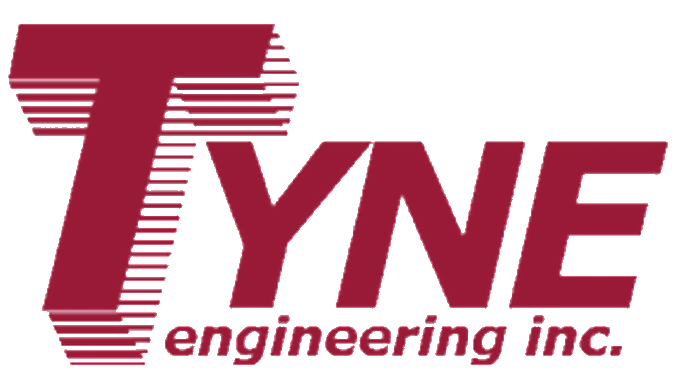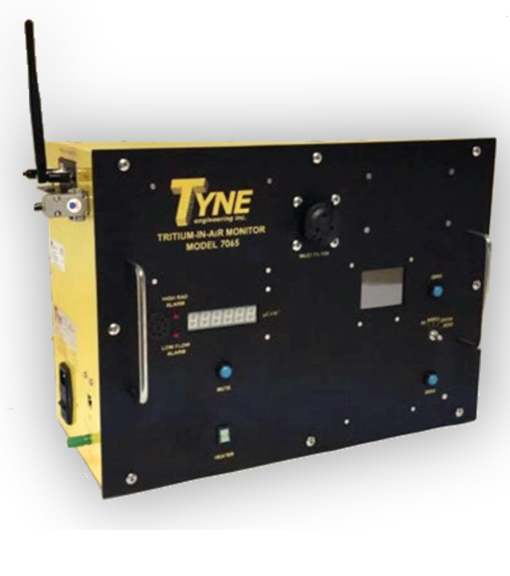
Wall Mount Tritium-In-Air Monitor
Model 7065
Tyne Engineering’s Model 7065 Wall Mounted Tritium-In-Air Monitor is an extension of our popular Model 7043 Portable Tritium Monitor. The 7065 is intended for room monitoring for both tritium and gamma with the convenience of simple wall mounting for ease of removal for calibration, maintenance or relocation.
- Simple to use, with only one operating switch with four settings of: Off, Sample, Pump, Set.
- Gamma Compensation with four large ion chambers arranged in a symmetrical configuration. Two chambers are used for measuring the air sample, and two are used for compensation.
- Better than 10% inaccuracy in 20 mR/hr field.
- High Sensitivity.
- The current amplification circuit employs ultra-low leakage technology. Each chamber has its individual amplifier, improving the signal-noise ratio of the analog circuit.
- Radon compensation is provided by the analog filter circuit designed to separate the radon spike from the tritium signal. The unit’s software can distinguish the radon spike from the tritium signal occurring as a slow-change.
- Ion-traps built into each ion chamber.
- Direct, wide range, gamma measurement provided using an installed GM tube.
- Decontamination easily performed by purging the ion chambers whilst simultaneously heating them using a centrally installed cartridge heater.
- Customer’s choice of hard-wired RS-232, Ethernet or an industry standard wireless connectivity.
- Self monitoring with low air flow alarm.
This instrument is designed for continuous tritium monitoring at a number of diverse locations in a nuclear facility. Communication can be via RS-232, Ethernet or Wireless system to a central radiation protection computer location. This provides near-real-time tritium and gamma monitoring at each location and is far superior to conventional central, manifold based, tritium detection systems.
Compensation for Gamma background is crucial in tritium measurement, since a gamma field of 1mR/Hr will generate 500 times the ionization generated by 1 uCi/m3 of tritium. Tyne designed the four ion chambers in this instrument in a symmetrical arrangement with each chamber connected to an ultra sensitive electrometer amplifier and filter. All signals pass through an ADC converter, and a micro-processor calculates and displays the measured tritium values. A separate, much smaller, ion chamber is used to cover higher tritium concentration ranges. The microprocessor also monitors air flow rate through the instrument using a solid- state flow meter. It also controls the chamber temperatures during the heated purge cycle.
Instrument output includes external communication via RS232, Ethernet and industry standard wireless to enable downloading or recording of information on a central radiation protection computer. The thin-film transistor (TFT) color LCD display mounted on the surface plate clearly displays instrument readings in both digital and graphic format showing real time measurements and trends. A separate, large digit, numerical display shows the current tritium values and is clearly visible at a distance.
The 7065 instrument is based on the same platform used in Tyne’s successful 7043 hand held tritium in air monitor. The wall mount version employs four ion chambers that are about 3 times larger than those used in the 7043 hand held instrument. This increases the sensitivity by a factor of three. The wall mounted instrument also employs a larger and more powerful, low noise, and high reliability pump. The pump is easily accessible by removal of the front panel. The 7065 instrument also allows for easy removal from the wall mounted location for ease of maintenance, repair or calibration.
The larger ion chambers, configured in a compact internal module, enable a sensitivity that precludes the need for Methane or P-10 counting gases and the need to use less reliable flow proportional counting systems. The 7065 ion chambers are robust and reliable. If they do become contaminated they can be purged by using an internally mounted heater whilst simultaneously pumping dry air through the ion chambers.
The unit employs a front panel mounted, high efficiency, internal inlet air filter to ensure that the ion chambers do not become contaminated. If required, a sniffer probe adapter can be provided with a length of tubing and the filter mounted at the end. The sniffer allows users to locate suspected tritium leaks by, for example, sniffing around a seal or flange to help tracing of leak origins. The sniffer is supplied with 15 meters of flexible, chemically resistant, tubing.
The front mounted LCD screen is touch sensitive and is used to change device settings, the alarm levels set, etc. The instrument has both visual and audible alarm annunciation. The audible alarm can be cancelled without canceling the visual annunciation. The touch screen panel is accessed by a two level password system. One password provides higher level access to Health Physics personnel to set up the device and the lower level password provides restricted access enabling operators to adjust alarms etc. The touch screen is augmented by use of a large digital read-out to provided better, longer distance, visibility for operators.
This wall mounted unit is powered by internal power supplies and only needs a standard 120 VAC three prong outlet to operate.


















